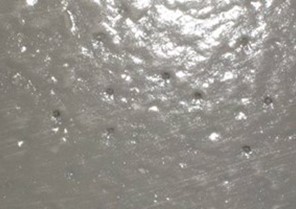




OVERVIEW: Pinholes affected the ‘wash area’ in an 800‐1000mm wide band below the tank’s centerline. Osmosis blistering resulted in crevice corrosion which was invisible at the coating application stage. These pin-holes measured 3-4 mm in depth and .5-1mm wide. Previous coating failure had developed a concentration cell with a difference in aeration, depleted of oxygen, which led to a highly corrosive condition in deepening the pinhole.

INDUSTRY
ENVIRONMENT
Produced water environment (coalescing) at 95°C
SUBSTRATE
Lining on produced water treatment vessel
CHALLENGE
The original coating was failing with osmosis blistering and exposure of the substrate to the cargo which caused localised corrosion pitting. Remedial work for this job needed to be completed along side ongoing repairs to ensure that the vessel arrived in Singapore in 2 years time for a refit. Corrosion rates of 2-3 mm per year would have reduced vessel’s corrosion allowance to zero resulting in a vessel perforation.
SOLUTION
Chemcote recommended that the affected areas be abrasive blasted and treated with repeated high pressure hot washes. A steam lance would heat the vessel up with steam to 400°C to remove salt from the pin-holes. Measurement of pinholes would ensure glass-flake epoxy coating filling. During the application of the coatings, metallic salt, environment and high voltage spark testing would be carried out to guarantee long life protection.
SCOPE
Abrasive blasting to remove coating
Salt tests revealed metallic salts, contaminated areas
After water washing and drying, abrasive blast to whip surface back to class 2.5
Spigots were blasted using angle nozzle
Whip blasting of floor and spigots for salt test
Area carefully hand painted to fill pinholes
Coating inspected and declared fit for purpose
Vessel boxed and pressure tested
PRODUCTS
OUTCOME
The vessel’s internal lining was replaced with corrosion resistant glass-flake filled epoxy resin. This film will protect the substrate and prevent further metal loss. The Chemcote team carried out the job successfully despite many challenges and maintained final coating quality much to client’s satisfaction. The pin-holing challenge was resolved by pit-filling and is to be reviewed in future NFT programs.
RELATED CASE STUDIES
Preventing blockages using Chemcote Solution
Condition of surface before mechanical preparation RB 364 applied to spot abrasive blasted surfaces Pugmill externals Coating with InD Cote Previous Next OVERVIEW: A
Base Plate Corrosion Prevention
Repairs required Application of Primer Coating applied to affected areas After application of Topcoat Previous Next OVERVIEW: A 40 year old excess gas bleeder structure
Industrial Fallout Protection
After whip abrasive blasting Application of Epo-chem system to internals Basalt Fibre application on internals OVERVIEW: A steel production plant contracted Chemcote to reinforce


